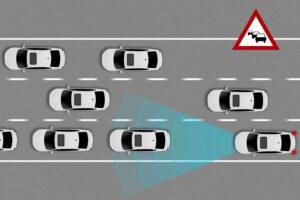
Ever since Heinrich Hertz demonstrated that radio waves were reflected by metallic objects, engineers have been putting the discovery to use in many range- and direction-finding applications. The technique is relatively straightforward; it requires a radio or microwave transmitter and a receiving antenna that captures signals reflected back from objects in the emissions path. Processing of the signals unveils some properties of the object or objects. This technique is commonly known as radar after the acronym RAdio Detection And Ranging.
Whereas radar has long been used in aircraft and ships to locate other vessels and terrain, its widespread use in automobiles is surprisingly recent.
Initially, short-range radar (SRR) for vehicles used the 24GHz frequency. The 24GHz systems are being used for short- and mid-range smart-driving features such as blind-spot detection and collision avoidance. Blind-spot detection radar covers the zone where the rear-view mirrors can’t see. This is especially useful on larger commercial vehicles. Collision avoidance provides a warning to the driver when their vehicle gets too close to an obstacle and is often combined with emergency braking assistance when the danger is high. In the last few years, these features have become common on high-end vehicles and are now moving into more economic models, too. Having been early to the 24GHz-system markets, ST has delivered over 35 million radar transceiver ICs to date.
The 77GHz band (from 76-81GHz), often called long-range radar (LRR), is the future for automotive radar. The technical advantages of the 77GHz band include that the higher frequency pairs effectively with a smaller antenna. The relationship between the antenna size and the frequency is linear, so 77GHz systems will need antenna sizes a third of the size of the current 24 GHz ones; in case you were wondering, the antenna is typically mounted in the vehicle bumper. The 77GHz devices also benefit from benefit from higher permitted transmit power. Perhaps most important, the wider bandwidth available in the 77 GHz band enables greater accuracy and, as a result, provide drivers with better object resolution. With some clever signal processing, this enhanced resolution will improve the detection and avoidance of big objects, like cars, and allow the avoidance of smaller ones, like pedestrians, too. This will complement the machine-vision systems that can already provide this accuracy but struggle in situations with poor visibility.
ST has a complete roadmap of 77GHz-technology radar ICs to complement its successful range of 24GHz products that continue to provide vehicles with the safety features previously available only on top of the range models. We also have the most advanced machine-vision ICs, which perfectly complement the radar systems and provide manufacturers with a complete ADAS solution.
